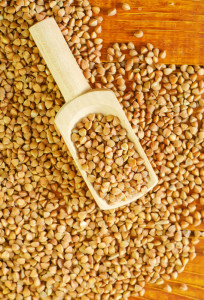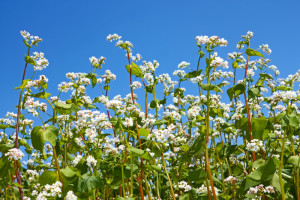With foods like Buckwheat being so readily available these days, then why so many people reach for factory made processed junk, is a total mystery to me?
Over and over again nature keeps reminding us just how good she is at creating nutritious and healthful food for we humans to thrive on, especially perfect plant food gems like buckwheat.

So, What is Buckwheat?
Agriculturists refer to it as a pseudo cereal. While the name leads us to believe buckwheat is a grain just like ordinary wheat, it is not, in fact it’s the fruit of a grass plant with a hard exterior or hull……in other words a seed and is a relative of the rhubarb family. It is actually a type of shrub-like plant native to the temperate regions of East Asia.
The buckwheat plant is bright green with broad heart-shape leaves and white flowers, and its seeds are harvested as a commercial, highly nutritious food source. These seeds are often referred to as buckwheat groats which are also made into a gluten free flour so is celiac friendly.
The plant tends to be short and broad, easily forming a notable level of ground coverage. Its cultivation in China dates back to 1000 AD.
Currently, buckwheat is cultivated worldwide with most of it growing in China, Japan, and North America. Over 14 species of the plant exist with two of them being cultivated species and the remaining existing in the wild.
If you like eating Japanese food then I am sure you will have had a bowl of green soba noodles at some time or another. Soba noodles are made from buckwheat flour whereas Udon noodles are made from normal wheat flour. The green colour comes from the addition of fresh green tea leaves.
Nutritional Content
Buckwheat contains a rich nutritional profile of protein, minerals, and fiber.
• The levels of copper, zinc, and manganese exceed the levels found in other cereal grains. The significant bioavailability of copper, zinc, and potassium also makes buckwheat a desirable addition to any diet. In addition, buckwheat does not contain gluten so people with gluten sensitivities or intolerance may safely consume pure buckwheat flour, groats, and grits.
• The protein content of buckwheat exceeds that of oats, one of the best plant sources for protein. Its protein content includes all eight essential amino acids with a strong concentration of lysine at six percent of its nutritional profile.
• Buckwheat grains contain high quantities B-complex vitamins, especially riboflavin (vitamin B2) and niacin (vitamin B3).
• The grains contain high levels of soluble and insoluble fiber, which helps with digestion and elimination.
• Gluten free so ideal for those with Celiac Disease or gluten sensitivity.
Health Benefits
People derive many health benefits from adding buckwheat to their diet.
• It is good for diabetics. The high fiber content slows the absorption of glucose in the bloodstream, helping to maintain healthy blood sugar levels and possibly lowering A1C.
• It supports the immune system. Copper, zinc and potassium are key minerals for establishing and maintaining a healthy immune system. Copper also supports the production of red blood cells.
• It helps heart health. The magnesium content of buckwheat assists with lowering blood pressure building balanced cholesterol levels.
• Buckwheat fights inflammation, a precursor and symptom of many systemic diseases. The polyphenols, water-soluble plant pigments with antioxidant properties, found in buckwheat combat inflammation and dysfunctional clotting in blood vessels.
Purchasing and Preparing
The seeds of the plant are harvested and processed in a variety of ways to make them available for various different uses. After removing the hull from the three-sided triangular shaped seeds, they may be added to cereals, coarsely ground into grits, finely ground into flour or roasted to make kasha.
Preparation methods for buckwheat groats and kasha include boiling, steaming and baking. The dishes serve the same role in meals as potatoes or rice. Buckwheat flour may also be added to sauces and gravies to thicken them and add additional colour.

Other uses for buckwheat include:
• Providing honey bees with nectar which they transform into a dark strongly flavoured honey
• A component of livestock feed used in combination with corn, barley or oats
• As a rotational cover crop to prevent weeds before planting another crop
• As a fertilizer crop to be plowed under to return nutrients and moisture to the soil prior to the next planting.
Buckwheat is a versatile and nutritious plant. This gluten free and nutrient dense food grows quickly making it a plentiful food source. Some people may get a skin rash when they eat buckwheat so be sure to monitor yourself for any signs of sensitivity.
Buckwheat is widely available and lends itself to a variety of preparations such as breakfast cereal, porridge, pancakes as well as grain salads, pilafs, Asian Soba noodles, snacks and also baking with buckwheat flour is becoming very popular. A favourite of mine is this buckwheat banana bread. I recommend you give it a try……you won’t be disappointed.
If you find the flavour of buckwheat too heavy or bitter then try blending it with other grains such as brown rice, quinoa or farro.
As you can see there are many benefits of buckwheat and to get you started cooking with buckwheat and enjoying its nutritional diversity here are 20 Buckwheat Recipes You Never Even Knew You Wanted.
So get started with some buckwheat in your diet and don’t forget to let me know your favourite recipe.
Thank-you for linking to my banana bread post! So glad you enjoyed it. 🙂
Pleasure Sarah…….it’s a great recipe and I am glad I was lucky enough to find it. Cheers – John F